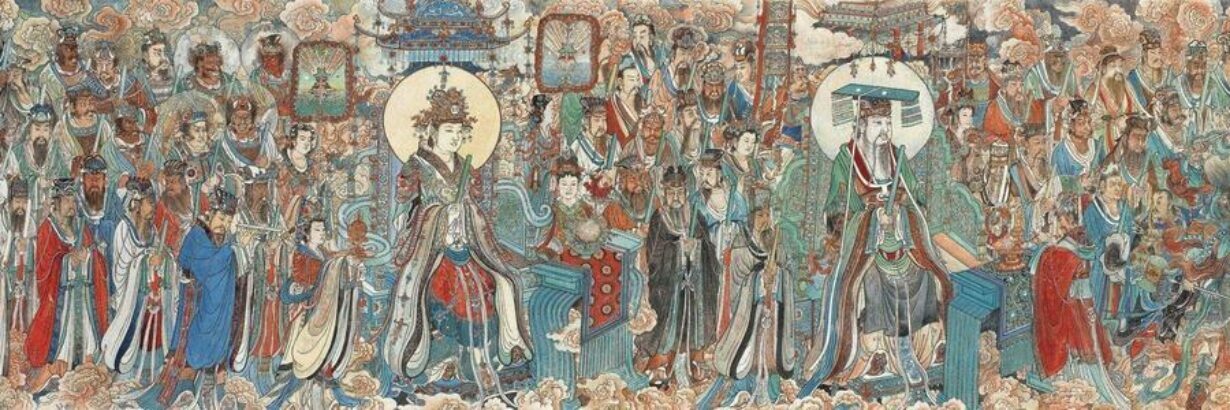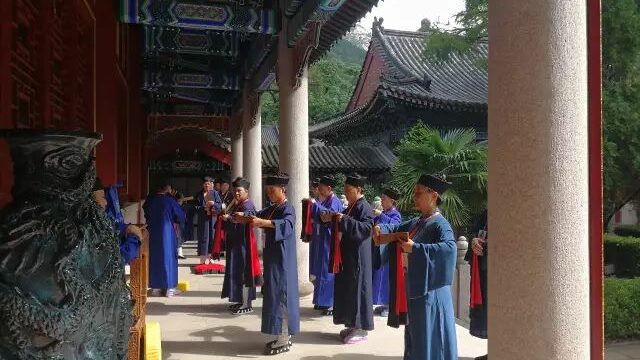Introduction of the ordination masters
The Great Taoist ordination (天仙大戒 Tian xian dàjiè) in the Quan Zhen Pai must include the participation and presiding of a Great Ordination Master (大律师, dà lǜshī), Chief Seat Master (总首座大师, zǒng shǒuzuò dàshī), and the “Eight Masters” (八大师, bā dàshī), along with the Altar Guardian Master (护坛大师, hù tán dàshī), etc.
The Eight Masters refer to the
- Precepts Altar Witnessing Master (戒坛证盟大师, jiètán zhèngméng dàshī),
- Supervising Master (监戒大师, jiānjiè dàshī),
- Recommending Master (保举大师, bǎojǔ dàshī),
- Ceremony Master (演礼大师, yǎnlǐ dàshī),
- Ritual Correcting Master (纠仪大师, jiūyí dàshī),
- Chief of Religious Study (提科大师, tíkē dàshī),
- Register Master (登箓大师, dēnglù dàshī),
- Inviting Master (引请大师, yǐnqǐng dàshī).

1. Ordination Master (传戒律师, chuánjiè lǜshī):
Also called “Primary Ordination Teacher” (传戒本师, chuánjiè běnshī) or “Great Ordination Master” (大律师, dà lǜshī), held by the abbot of the ordination temple, responsible for teaching the precepts and laws to the disciples.
2. Chief Seat Master (首座大师, shǒuzuò dàshī):
Also called “General Manager Master” (总理大师, zǒnglǐ dàshī), assists the Ordination Master, responsible for all matters of the law altar.
3. Precepts Altar Witnessing Master (证盟大师, zhèngméng dàshī):
Explains the doctrines, classics, and ritual etiquette to the disciples.
4. Supervising Master (监戒大师, jiānjiè dàshī):
Supervises the disciples’ conduct and punishes those who violate the precepts according to the laws.
5. Recommending Master (保举大师, bǎojǔ dàshī):
Recommends disciples for ordination and oversees all affairs of the temple. This position is usually held by the supervising abbot of the ordination temple.
6. Ceremony Master (演礼大师, yǎnlǐ dàshī):
Teaches the disciples the rituals, ceremonies, and altar etiquette.
7. Ritual Correcting Master (纠仪大师, jiūyí dàshī):
Corrects the disciples’ rituals and maintains the altar’s dignity.
8. Chief of Religious Study (提科大师, tíkē dàshī):
Oversees the chanting, scripture recitation, and other devotional activities.
9. Inviting Master (引请大师, yǐnqǐng dàshī):
Also known as the “Welcoming Master,” responsible for organizing the rituals for welcoming and sending off the abbot and other masters to and from the altar.
10. Register Master (登箓大师, dēnglù dàshī):
Assigns the Taoist name to the disciples and records it in the “Register of Immortality” (《登真箓》, Dēng Zhēn Lù).
Additional Roles in the Ordination Process
There are also Altar Guardian Masters (护坛大师, hùtán dàshī) who assist the Chief Seat Master and the Eight Masters. They are responsible for maintaining the dignity and order of the altar during the ordination process, ensuring the rituals proceed in a lawful and dignified manner.
1. Inspecting Master (纠察大师, jiūchá dàshī):
Maintains the discipline and dignity of the altar and corrects the disciples’ rituals.
2. Scripture Master (主经大师, zhǔjīng dàshī):
Responsible for scripture chanting and devotional services.
3. Master of Documentation (主翰大师, zhǔhàn dàshī):
Responsible for official documentation and communications during the ordination.
Basic procedures for Ordination
The Ordination Master (传戒律师, chuánjiè lǜshī) is held by the abbot of the ordination temple, responsible for explaining the precepts and transmitting the ordination laws to the disciples, i.e., the overall person in charge of the ordination activity. Among them, the Ordination Master, Precepts Altar Witnessing Master (证盟大师, zhèngméng dàshī), and Supervising Master (监戒大师, jiānjiè dàshī) are collectively known as the “Three Masters” (三师, sān shī) of the ordination altar and are the three main leaders of the ordination altar.
The ordination activity of the 全真派, Quánzhēn pài generally includes the following procedures:
- Raising the Banner,
- Posting the Proclamation,
- Opening the Altar,
- Drawing Water,
- Purifying the Impurities,
- Welcoming the Masters,
- Inviting the Saints,
- Blessing the Generals,
- Ceremony Demonstration,
- Examination of Precepts,
- Verse Examination,
- Chanting Scriptures
- and Performing Repentance Rituals,
- Submitting the Great Petition,
- Explaining the Precepts,
- Transmission of the Robe and Bowl,
- Issuance of Ordination Certificate,
- Submitting Petition to Thank the Gods,
- Great Dedication,
- Lowering the Banner
- and Sending off the Gods, etc.

Ordination Proclamation
- Raising the Banner (扬幡, yángfān): The ordination activity begins with the solemn “Raising the Banner Ritual,” the purpose of which is to swear to the heavens, the earth, and the deities that the temple is about to open the altar to conduct the ordination, requesting their benevolent protection.
- Posting the Proclamation (张榜, zhāngbǎng): This refers to posting and reading aloud the proclamation to announce to the four directions of heaven and earth the time, place, and meaning of the ordination at a famous Taoist temple or mountain, and informing who the abbot Ordination Master presiding over the ordination altar is.
- Purifying the Impurities (荡秽, dànghuì): This is done at the beginning of the large-scale ritual, where holy water is used to purify the altar site. Through the ritual, the deities are informed and requested to descend and guard the altar.
- Welcoming the Masters (迎师, yíng shī): All the Taoist priests of the temple and the disciples attending the altar solemnly welcome the abbot master to preside over the ordination activity in the form of a ritual ceremony.


- Ceremony Demonstration (演礼, yǎn lǐ): The Ceremony Master (演礼大师, yǎnlǐ dàshī) takes the lead in demonstrating the ritual etiquette and the use and handling of the instruments, ordination objects, and official attire issued by the ordination altar to the disciples.
- Examination of Precepts (审戒, shěnjiè): The masters preside over the altar, where they and the disciples face each other, swearing allegiance according to the ritual regulations. The masters question the disciples one by one about the precepts, asking if they can uphold them. If a disciple shows uncertainty, they cannot pass this test and are not allowed to continue participating in the ordination rituals at the altar.
- Verse Examination (考偈, kǎo jì): The ordination altar sets examination topics beforehand, mainly to test the literary and scholarly abilities of the disciples. Through this process, the masters can gain insight into the disciples’ talents and aspirations, assisting in the future development of Taoist talents. After the verse examination, the names are ranked according to the “Thousand Character Classic” (《千字文》, Qiānzìwén).
- Explaining the Precepts (说戒, shuōjiè): The core of the ordination is the “Explaining of the Precepts.” The ordination itself is primarily to teach the precepts and laws to the disciples, helping them understand the precepts. Usually, the abbot of the temple or monastery (referred to as the abbot in the Full-True Sect) serves as the Ordination Master, personally presiding over the altar and explaining the teachings.
- Issuance of the “Purification Ordination Certificate” (颁发《净戒牒》, bānfā jìngjiè dié): From this moment, a “Lay Taoist” is officially promoted to a Taoist and is recognized and accepted within the Taoist community and heaven. According to Article 12 of the “Regulations on the Ordination of Taoists in the Quan Zhen Pai,” ordination is based on the “Initial True Precepts” (《初真戒》, Chūzhēn Jiè) consisting of the Three Refuges, Five Precepts, and Ten Precepts, along with the Nine Precepts for Female Taoists. The “Middle Extreme Precepts” (《中极戒》, Zhōngjí Jiè) consisting of the great 300 precepts, and “Heavenly Immortal Precepts” (《天仙戒》, Tiānxiān Jiè) the “True Heart Precepts”.
Written and Translated by Daoist Liu Cheng Yong, German Daoist Association.



